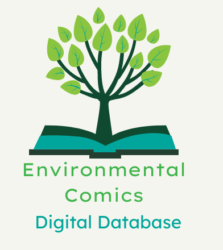Visualizing Representations of Gender and Race in Environmental Comics
Who gets to save the world in an environmental comic, and who gets left out of these narratives? To address these questions, these data visualizations draw from 72 children’s and YA environmental comics from a variety of genres. The charts include data about 62 unique protagonists; a protagonist who appears in multiple volumes of a series is only counted once.
** This database utilizes the same labels for ethnicity and race as the Diverse Book Finder website.
Representations of Gender in Children’s and YA Environmental Comics
This chart visualizes the frequency of representations of gender in children’s and young adult comics. Use the dropdown menu to filter by level of environmental agency.
Building on this data, this chart examines the intersections between gender and environmental agency in the comics.
Representations of Race in Children’s and YA Environmental Comics
This chart visualizes the frequency of representations of race in children’s and young adult comics. Use the dropdown menu to filter by level of environmental agency.
Additionally, this chart depicts levels of environmental agency based on the race of the protagonists.
Intersections of Gender and Race in Children’s and YA Environmental Comics
Key Takeaways
- Animal/Nonhumanoid characters make up 22 out of the 62 protagonists (35%). This statistic reflects larger trends in children’s literature. For instance, the School Library Journal estimated that 27% of children’s books published in 2018 included protagonists who were “Animals/Other.”
- 17 out of 62 protagonists (27%) appeared to be white.
- Asian and Indigenous/Native American characters were the most underrepresented in the dataset, with only 1 character from each identity.
- 30 out of 62 protagonists (48%) were female. Only 15 out of 62 (24%) protagonists were male — half the rate of female protagonists.
- Additionally, 13 out of 62 (21%) comics in the sample featured Mixed Gender Casts, where female and male characters had equal roles as protagonists.
- Female protagonists were most likely to exhibit Moderate, Plot-Driven Environmental Agency or High Environmental Agency and Activism. No female protagonists displayed Very Low Levels of Environmental Agency by noticing but failing to act on environmental issues.
- Male protagonists were most likely to exhibit Considerable Environmental Agency Without Activism, meaning that they raised awareness of or expressed significant concern for environmental issues but failed to take concrete steps to address them.
